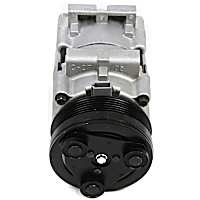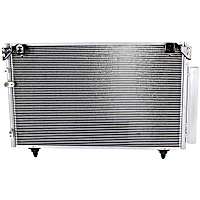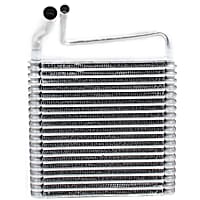Once your car air conditioning decides to quit working, you end up in panic mode, especially in the summer. After all, who wants to arrive at work drenched in sweat? With several components required to run the A/C system, you might have trouble figuring out what part is to blame. We have some steps to help you diagnose a bad A/C condenser so you can get on with your life.
Can You Drive with a Failed A/C Condenser?
It’s not comfortable to drive in warm weather without a working condenser, but this won’t harm your vehicle. Still, you don’t want to just ignore the problem.
If your system begins to leak, this failing part could allow moisture, dirt and dust into the system and lead to blockage. This might require additional repairs. That’s why you must perform diagnostics at the first sign of trouble.
Causes of Condenser Failure
Condenser failure occurs for two main reasons. The first probable cause is that the condenser began leaking. There are seals on the part that leak with normal wear and tear. The condenser tubes can’t be replaced, so you need a new condenser if it cracks or breaks. It’s also possible for the leakage to occur when physical damage stems from road debris or rocks. Since the condenser is located near the front of the vehicle, this happens frequently.

The second cause is that there is a blockage caused by metallic debris. This blocks the required circulation from happening. Typically, this results from a defective or failing compressor that breaks apart. As the internal parts disperse, the metallic debris ends up throughout the entire system. In this situation, you might need more than a condenser, but also the tubes, receiver dryer and compressor.
Troubleshooting a Leaky A/C Condenser
There are two main procedures when it comes to finding a leak in the A/C condenser. One is used by us mechanics at the dealership and the other method works well at home. Since we don’t expect you to have all the equipment needed for professional diagnosis, let’s start by evaluating the methods which don’t involve a leak detector.
No Leak Detector Required
Step #1: With a fully charged A/C system, spray a water and heavy soap mixture on the components of the car’s air conditioning system.
Step #2: Watch for leaks to appear. You won’t be able to try this method with evaporator or compressor front seal leaks.
It’s also possible to purchase Freon dyes that utilize a black light. Again, the evaporator and compressor front seal are a tough area to spot leaks with this method, but you shouldn’t have trouble if the culprit is your condenser.

If a small leak is present, you may be able to repair it with a Stop Leak product. If you notice visible holes or clear damage to the condenser, you have no option but to replace it. While I realize this is a pain, it’s the only way to ensure that your air conditioning works properly.
What if There is No Leak?
If you finish your leak testing without any incident, your next step is to look for a clogged condenser. Checking your pressures is the next logical place to start. With a clogged condenser, you will notice higher pressures even though you have the right amount of refrigerant in the system. These higher pressures are noticed on both the high and low side.
Condensers are subject to clogs because of the leftover particles in the refrigerant. As the condenser converts refrigerant, residue tends to remain at the bottom. It eventually turns into a sticky paste that hinders conversion.
Leak Detector Required
If your system doesn’t show any immediate signs of leakage, then you want to purchase a leak detector.
Step #1: Make sure the system is full of Freon. You also want the engine to be turned off. Ideally, there should be no breeze or wind. Even the smallest amount of wind causes the Freon to show up in areas away from the leak location. This might lead to a false reading. Consider checking your vehicle in a garage to be certain no outside factors affect your readings.

Step #2: Turn on your detector and adjust it to the lowest sensitivity setting. You will test the O rings first since this is a common place for leaks to occur. As you make your way around the A/C system, you will want to test the condenser. It often gets hit with debris and small rocks which can cause a leak. As you examine the condenser, don’t forget to look at the hose connections as well.
Step #3: Listen for a rapid beep as a sign. These signals indicate a leak. If you don’t receive any alerts to a leak, you want to adjust the sensitivity settings and scan again. Continue to move up in sensitivity as you scan.
The biggest sign that you have a clog other than the pressure check is a foul smelling odor during air circulation. When a clog is apparent, you have the option to attempt a flush or replace the condenser. At the dealerships, we’ve had many customers force us into a flush. While it might look like an easy solution, be forewarned, you might end up with bigger problems.
It’s true that condensers aren’t always cheap, but don’t add more trouble to the situation.
What if the Condenser Isn’t the Problem?
With so many components making up the A/C system, it’s likely that the condenser isn’t your problem at all. Many times, bad evaporators, leaks in the lines or a lack of refrigerant can cause the same symptoms. When in doubt, seek the help of a professional for further guidance.
Get Back in the Cold Again
You don’t have to be an ASE Certified Master Tech to find the culprit of your A/C system problems. Get your tools gathered and start the hunt. Once you’ve determined the problem, it’s time to move on to getting the repair done.
How to Get a Replacement A/C Condenser
A broken A/C condenser might not seem like a pressing issue, but it can actually damage other parts of your A/C system. If ignored for too long, it might allow moisture and dirt into the system. All that debris can clog the system and interfere with the functionality of other components. To save yourself from a hefty repair bill, it’s best to replace it as soon as possible. Luckily, getting a new A/C condenser is fast and easy with CarParts.com.
CarParts.com offers a wide selection of A/C condensers, all sourced from the most trusted manufacturers in the industry. Easily browse through our catalog with the help of our vehicle selector and search filters. Just enter your vehicle’s details, and you’ll see all the available parts that are compatible with your ride. Thanks to our strategically located warehouses around the US, CarParts.com also guarantees fast shipping. Order by 12 PM ET, and you can expect your new A/C condenser to arrive in as fast as two business days.
Don’t wait for other parts of your A/C system to fail before replacing your A/C condenser. Check out our catalog of high-quality A/C condensers at CarParts.com and order today!
Products Mentioned in this Guide
Any information provided on this Website is for informational purposes only and is not intended to replace consultation with a professional mechanic. The accuracy and timeliness of the information may change from the time of publication.


 A/C Compressor
A/C Compressor
 A/C Condenser
A/C Condenser
 A/C Evaporator
A/C Evaporator





























